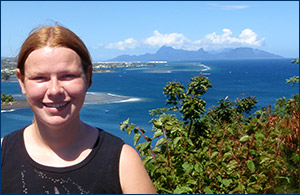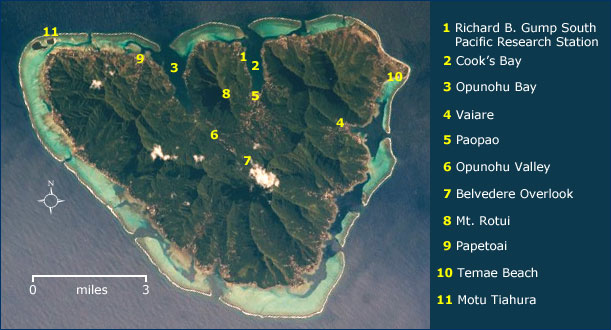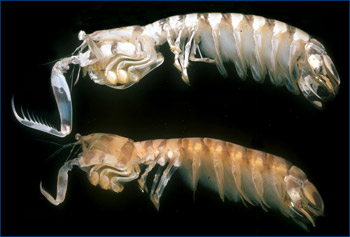Online Exhibits : Field notes : Molly Wright
Monogamy in mantis shrimp: Field notes from Molly Wright
By UCMP grad student Molly Wright, September 12, 2008
 |

Molly on the island of Tahiti. That's Moorea with the clouds over it in the background. *Click on the photo to see an enlargement.
|
| Molly is a graduate student in the Department of Integrative Biology who is interested in the evolution and reproductive behaviors of mantis shrimp (stomatopods). As a teaching assistant for a course on the biology and geomorphology of tropical islands being taught on Moorea in French Polynesia, she'll have a great opportunity to collect specimens for her research. |
September 12, 2008
Arrival in Moorea
I've just arrived at UC Berkeley's Richard B. Gump South Pacific Research Station on the island of Moorea in French Polynesia, following a 12-hour flight across the Pacific Ocean. I'm sleepy and jetlagged, but incredibly excited to be in such a lush, island setting. Even though it was dark as we made the bumpy drive from the tiny airport to my new home, the scenery was striking. Moorea, part of the southern rim of a volcanic caldera, is mountainous, with high peaks (Mount Tohivea tops out at 3960 feet). A single road rings the island, with small towns built up along it. Everything is lush and there are brilliant flowers everywhere! |

The island of Moorea as seen from the International Space Station. Note the coral reefs ringing the island. Many of the locations that will be mentioned in Molly's reports are indicated.
|
 |
I'm here both as a researcher and as a teaching assistant for an amazing UCB class: Integrative Biology 158C, Biology and Geomorphology of Tropical Islands. As a third-year graduate student, I am commencing my dissertation field research on the evolution and reproductive behaviors of mantis shrimps. Mantis shrimps (also know as stomatopods) are not actually shrimps, but are instead a distant relative of all decapods (shrimp, crabs, and lobsters). Their formidable raptorial appendages, which are used in foraging, pack quite a punch. In the species Odontodactylus scyllarus, which uses its appendage to smash open snail shells and crab carapaces, the smashing forces reach levels equaling the force from a 50-caliber rifle!

A male (top) and female stomatopod pair (Pullosquilla maculata).
|
 |
For my dissertation research, I am studying a group of mantis shrimps with a highly unusual mating system — monogamy. Monogamy, biologically defined as when a male and a female mate exclusively for at least one breeding cycle, has been poorly studied in animals other than birds and mammals. Some species in the group of mantis shrimps that I study, the Lysiosquilloidea, live as male-female pairs in U-shaped burrows on sandy bottoms in the ocean. I'm interested in figuring out why the males and females do not seek other mates. For this investigation, I'll study how factors like food availability, population density, and sex ratio influence the number of males with which females mate in Pullosquilla litoralis, a small monogamous species. Here in Moorea, I will be collecting pairs of shrimp with eggs. Back at UCMP, I will run paternity tests on the eggs in the Molecular Phylogenetics Lab to determine if the paired male is actually the father of the eggs.
I am also trying to figure out how and why monogamy evolved in this group. To do this, I first need to build an evolutionary tree that includes species in my group of interest. I am collecting many species of Lysiosquilloidea from across the Indo-Pacific, including right here in Moorea. At UCMP, I will be extracting their DNA and comparing several genes to determine their relatedness. I will then use the evolutionary tree to determine how many times monogamy evolved in the Lysiosquilloidea.
Time for me to hit the sack. I'm so excited to see Moorea by daylight. Tomorrow, I'll give you all a little background on the course that I am helping to teach and share some pictures of Moorea during the day!


